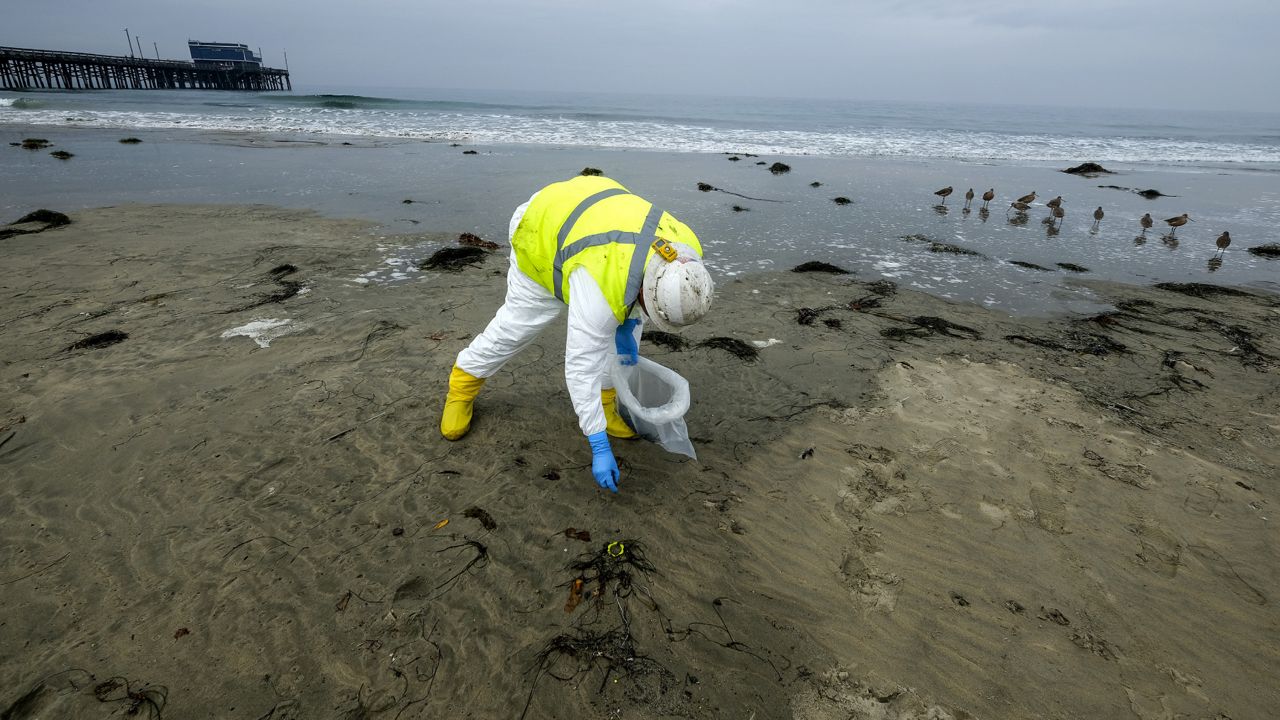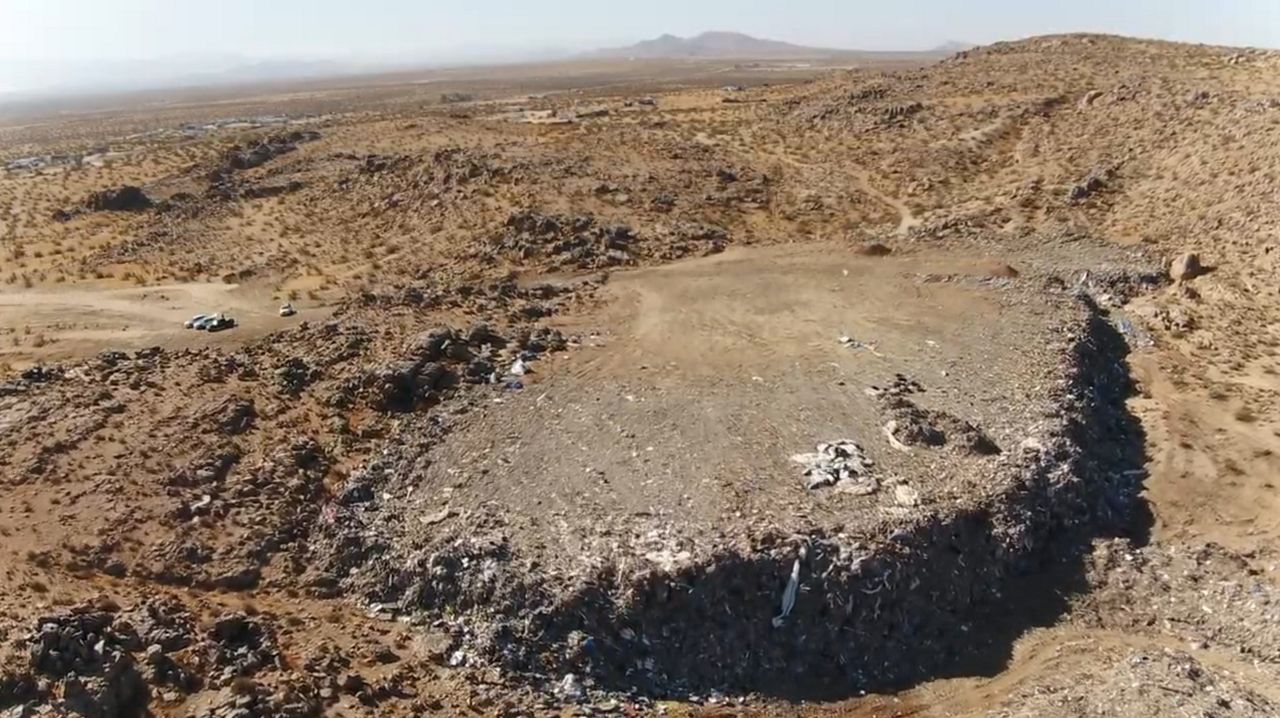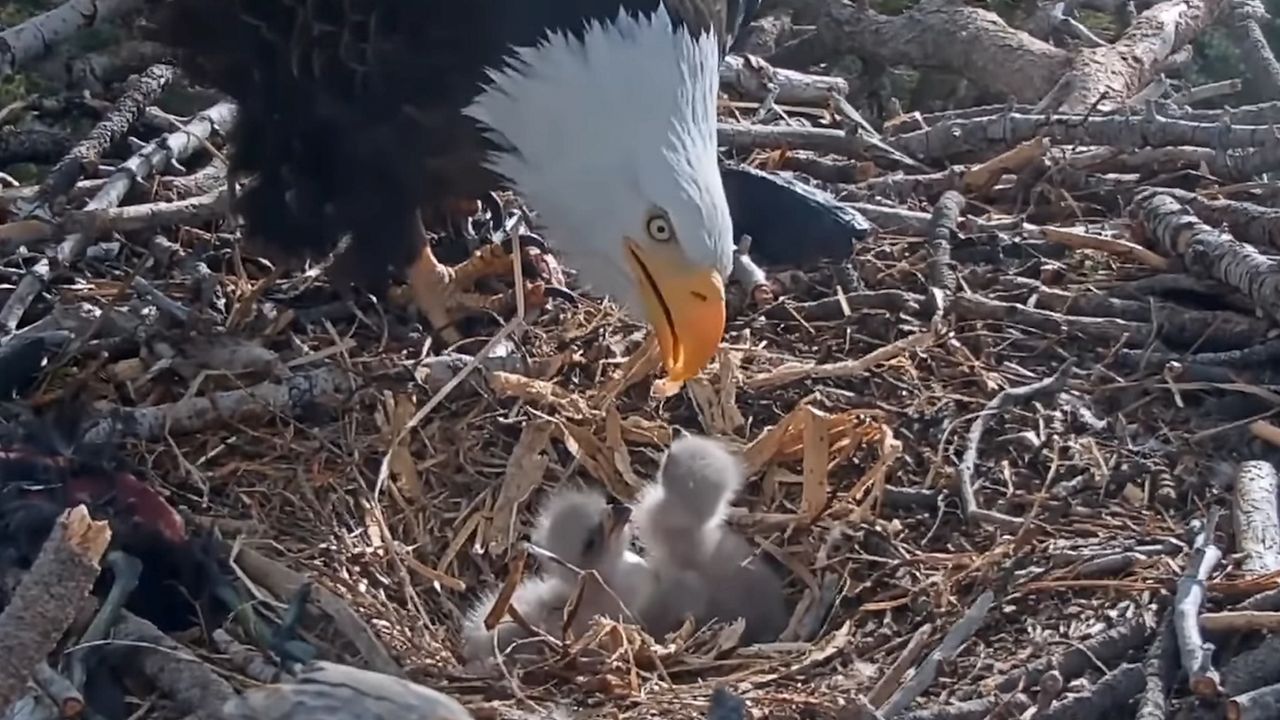HUNTINGTON BEACH, Calif. (CNS) — Officials Thursday were speculating that the volume of oil leaked off the coast of Huntington Beach might be much less than initially anticipated.
Authorities earlier this week were bracing for a worst-case scenario of about 144,000 gallons of oil, but on Thursday, it appeared it could be as low as 30,000 gallons.
"There's speculation of about 30,000 gallons, but that's not been confirmed," Orange County Supervisor Lisa Bartlett said. "But that would make more sense," adding that the amount of wildlife so far affected by the spill does not reflect a larger oil spill.
At a news conference Thursday afternoon, a U.S. Coast Guard official estimated that roughly 588 barrels of oil had spilled, which would equate to about 24,700 gallons.
Bartlett said Coast Guard officials were considering what effect a 4.4-magnitude earthquake centered in Torrance might have had on the pipeline several days before the leak.
The county on Thursday reopened the beaches under its jurisdiction in Dana Point, which include Salt Creek Beach, Strands Beach and Baby Beach within Dana Point Harbor. Capistrano Beach and Poche Beach remain closed because of construction.
Beachgoers were advised to avoid any visible oil on beaches and harbors in Dana Point and Newport Beach, which remain closed for traffic both in and out.
Meanwhile, congressional leaders were pressing the federal agencies investigating the leak for regulatory information on Amplify Energy, the company that owns the oil rig.
Amplify CEO Martyn Willsher insisted the company was unaware of any release of oil into the ocean until about 8 a.m. Saturday, adding that the firm responded and reported the incident immediately.
The U.S. Department of Transportation's Pipeline and Hazardous Materials Safety Administration's Office of Pipeline Safety issued a corrective action order Tuesday, saying workers in the company's control room "received a low-pressure alarm on the San Pedro Bay Pipeline, indicating a possible failure at about 2:30 a.m. Saturday," but the pipeline carrying crude oil was not shut down until about 6 a.m. Saturday.
Asked repeatedly about that timeline during a Wednesday media briefing in Huntington Beach, Willsher said only that the company was cooperating fully with federal and local investigators
"We are working with them, giving them all the transparency and information that we have," Willsher said.
As for whether there was an alarm that alerted crews to a pressure drop, he said. "We are conducting a full investigation of that ... to see if there was anything that should have been noticed."
But he questioned whether there were any signs of alarm.
"I'm not sure if there was a significant loss of pressure," Willsher said, adding that when his company's crews saw oil in the water at 8:09 a.m., an emergency response was initiated.
"We did not take any additional time," he said. "People were notified very, very quickly."
Willsher said his company was also unaware of any reports of a sighting of oil in the water as early as 6 p.m. Friday.
"If we were aware of something Friday night, I promise you we would have immediately stopped all operations and moved forward," he said.
Willsher did not participate in Thursday's news conference, and the company did not immediately respond to a message.
Ore said about 800 workers were combing the beaches and water for oil. About 5,544 total gallons of crude oil has been recovered and 12,860 feet of containment boom have been deployed.
Michael Ziccardi of the Oiled Wildlife Care Network said 19 live birds and five dead birds have been recovered, including five federally threatened Snowy Clovers, which were expected to survive. The team had to use special traps to corral the birds, he said.
"They have a very good chance of survival," Ziccardi said.
Divers contracted to investigate the source of the leak confirmed that a large section of the 17.7-mile pipeline was moved out of place by as much as 105 feet, and a 13-inch "split" in the line was detected in the displaced section 4 1/2 miles off shore.
According to the unified command responding to the leak — including the Coast Guard, state Department of Fish & Wildlife and Amplify Energy — a 4,000-foot section of the pipeline was "displaced," or bent laterally by a maximum of 105 feet.
Ore reiterated Thursday that the split is the "likely source" of the leak, which forced the closure of Orange County beaches and some harbors. She said no more oil was seen coming out of the break in the line.
Willsher said the pipeline is a 16-inch steel pipe covered in concrete, indicating it would take a great deal of force to move and rupture it. He said the "pipeline has been pulled like a bow string," and "is in almost a semi-circle."
He confirmed Monday that the possibility of a ship's anchor causing the break was among the options being examined as a potential cause. That possibility gained credence in the federal corrective action order issued to the company's subsidiary, Beta Offshore, on Tuesday.
"The root cause of the accident remains unconfirmed at this time," according to the federal document. "Preliminary reports indicate that the failure may have been caused by an anchor that hooked the pipeline, causing a partial tear."
The federal report states that the damaged pipe is about 98 feet below the ocean surface. The pipeline was installed in 1980.
Orange County's emergency management director Michelle Anderson told supervisors on Tuesday that spill estimates ranged between 120,000 to 150,000 gallons of oil. The plume had drifted as far south as Dana Point, shutting down harbors from Newport to Dana Point. There are reports now of tar showing up on beaches in Oceanside, Ore said.
Ore said oil will continue flowing south with the current.
An estimated 15.67 miles of light oiling has been reported along Orange County shorelines, according to the unified command.
Beaches throughout Orange County remained mostly closed as efforts continued to scoop up tar and oil stemming from the massive spill.
Huntington Beach Mayor Kim Carr said the part of the beach under city control has always been open to some access to the sand, but not to the water. The state-run beaches are fully closed.
Newport Beach offered some access with visitors welcome to go on the sand, but not in the water. Vessels within Newport Harbor can continue operating in the harbor but boats are not allowed in or out to keep them from spreading oil, city spokesman John Pope said.
The damage in Newport Beach is mainly concentrated on the west side from the Santa Ana river down to 52nd Street, Pope said. Some tar and oil has been seen further down the peninsula, but it's not as slick, and there has been some tar showing up in Corona Del Mar, he added.
Seal Beach's beaches remain open because officials say the oil slick has not affected their shores.
Bartlett and Orange County CEO Frank Kim said they were pleased with the ramping up of efforts to clean up after the spill.
"The response has been great," Bartlett told City News Service. "It's been all hands on deck. They've done a fantastic job."
Kim called for more urgency in responding to the spill earlier this week but by Thursday, was pleased with the pace.
"Like with any emergency response the first day or two is difficult while the infrastructure is being stood up," Kim told City News Service. "But I do think the unified command has hit its stride ... at least from what I'm seeing on my end, I've been happy the response has increased and the communication has improved."
State Sen. Tom Umberg, D-Santa Ana, told City News Service, "Right now the focus should be ... containment, cleanup and recovery. Right now, our focus needs to be on those three things."
Once those goals have been accomplished, the attention can turn to potential culprits, negligence or wrongdoing, Umberg said.
"Then, we can start figuring out whether someone needs to be prosecuted or an entity needs to be prosecuted or whatever else needs to be done to prevent this from happening again in the future," Umberg said.
Assemblywoman Cottie Petrie-Norris, D-Laguna Beach, who chairs the Accountability and Administrative Review committee, told reporters at Thursday's news conference that, "Yes, our community deserves answers and, yes, we will get those answers." She pledged to hold hearings as soon as possible.
Officials have established a phone line for claims from residents or businesses affected by the spill. Anyone with a claim was asked to call 866-985- 8366 and use "Pipeline P00547" as a reference.
Residents were asked to not try to rescue any oiled animals, but to instead report injured wildlife by calling 877-823-6926, or 877-UCD-OWCN. Interested volunteers must take a four-hour course to train for clean-up efforts and wear special personal protective equipment. Anyone interested can get more details at calspillwatch.wildlife.ca.gov/volunteer or by calling 800- 228-4544.
While the spill was not reported until 9 a.m. Saturday, some people reported smelling oil in the water late Friday. Members of the unified command confirmed that the National Response Center received a report of an unknown sheen on the water Friday night, but such reports are common and often turn out to be unfounded. State teams responded to the area to investigate the report before sunrise on Saturday, but were unable to properly investigate due to foggy conditions. The Coast Guard and Orange County sheriff's officials deployed after daybreak.
Ore said when a call of an oil slick came in Friday night, the Coast Guard followed a standard protocol with a phone call to the reporting party. She said it was too dark to determine whether it was an oil slick, so the Coast Guard followed up at dawn.
"It took about two hours on Saturday morning to detect oil in the water," Ore said.
The state Department of Fish and Wildlife has ordered the closure of Southern California fisheries in response to the spill, prohibiting the taking of fish and shellfish from Huntington Beach to Dana Point.
The spill occurred in federal waters at the Elly oil-rig platform, built in 1980 to process crude oil from two other platforms, which draw from a large reservoir called Beta Field. Elly is one of three platforms operated by Beta Operating Co., which also operates Ellen and Eureka nearby. Elly processes oil production from Ellen and Eureka and is fed by some 70 oil wells. The processing platform separates oil from water.
Elly is one of 23 oil and gas platforms installed in federal waters off the Southern California coast, according to the Interior Department's Bureau of Ocean Energy Management. Besides Elly, a processing facility, there are 20 others that produce oil and gas, and two are being decommissioned.
The offshore platform system has been linked to earlier leaks, including a 2,000-gallon spill that led to a $48,000 federal fine against the operator for improper calibration of a leak-detection system. The corroded pipeline carried oil, water and gas from Eureka to Elly, the Los Angeles Times reported about the 1999 incident.
The spill was reminiscent of another ecological disaster decades ago. An estimated 3,400 birds were killed when the American Trader oil tanker ran over its anchor and punctured its hull on Feb. 7, 1990, spilling an estimated 416,600 gallons of crude oil off the coast of Huntington Beach.
As a result of the spill, the Wetlands and Wildlife Care Center was established March 31, 1998, at 21900 Pacific Coast Highway to help injured and orphaned wildlife including oil-soiled birds. A makeshift facility at that site treated birds injured in the 1990 spill, according to the center's website.










